Edward Arthur Fellowes Prynne
Edward Arthur Fellowes Prynne (1854–1921) was a leading British late Pre-Raphaelite painter of portraits and subject pictures, who in later life became one of the country's best-known creators of decorative art for churches.[1][2]
Edward Arthur Fellowes Prynne | |
|---|---|
_(14804065543).jpg.webp) | |
| Born | 14 October 1854 Plymouth, Devon, England |
| Died | 28 December 1921 (aged 67) Ealing, Middlesex, England |
| Resting place | St Mary the Virgin Church, Hayes |
| Nationality | English |
| Notable work | Figurative painting |
| Movement | Pre-Raphaelite |
| Spouse | Emma Mary Joll |
| Children | Beatrice Mary Fellowes Prynne (1893–1993), Dorothy Etheldreda Prynne (1894–1983), George Michael Fellowes Prynne (1896–1973), Stella Christine Marie Prynne (1898–1957) and John Rundle Fellowes Prynne (1903–1931) |
| Parents |
|
| Relatives | George Fellowes Prynne (brother) |
| Memorial(s) | St Peter's Church, Ealing |
Family and early life

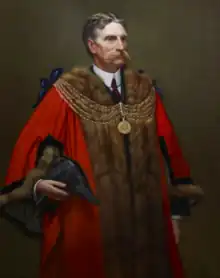
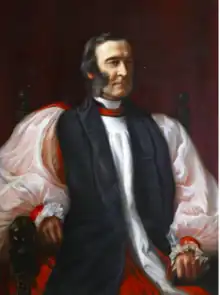


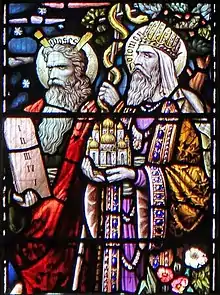

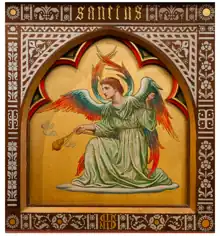
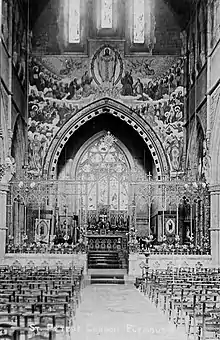
Born in Plymouth on 14 October 1854, Prynne was the third son of Emily Fellowes (daughter of Admiral Sir Thomas Fellowes KCB DCL), and the Cornish Revd George Rundle Prynne, the notable tractarian and ritualist. His brother was the church architect George Fellowes Prynne.[3] Prynne was educated at Eastman's Royal Naval Academy in Southsea, being originally intended for the navy. But at the suggestion of Frederic Leighton, he decided to embark on an artistic career. After preliminary training in art schools in London, he travelled to Antwerp, where he studied with the Belgian painter Charles Verlat. Subsequent study was undertaken in Florence, Paris and Rome.[4][5]
Prynne married Emma Mary Joll in 1888, with whom he had two sons and three daughters: Beatrice Mary Fellowes Prynne (1893–1993), Dorothy Etheldreda Prynne (1894–1983), George Michael Fellowes Prynne (1896–1973), Stella Christine Marie Prynne (1898–1957) and John Rundle Fellowes Prynne (1903–1931).[1][6] On moving to London in the 1880s, he lived at 8 Avonmore Road in Kensington Olympia (later home of the author Gavin Maxwell). He subsequently lived for over 20 years at 1 Woodville Road in Ealing. Prynne and his family became part of the community of artists living in Ealing. He was a member of Ealing Art Group, and was present at their first meeting in 1911. Prynne and his family attended St Peter's Church, Ealing.[7][8]
Work
Prynne's early paintings show a clear debt to his teacher Charles Verlat. Soon after his return from the continent however, the artist fell under the influence of the Pre-Raphaelite school of painting, especially of Edward Burne-Jones, influencing the whole of his subsequent work.
Prynne excelled across a range styles and subjects. He was a highly skilled traditional portrait artist whose works were commissioned by members of the royal family and politicians. He painted over 60 portraits, including a commission to paint a life-size portrait of the Duke of Edinburgh, as Admiral of the Fleet. By command of Queen Victoria, he attended Osborne House to show this portrait, which was later hung in the Royal Naval Barracks at Devonport.[5] Prynne also painted often almost psychedelic mythological and religious pictures. Notable among these were 'Cophetua's Queen,' 'Orpheus and Eurydice,' 'Pan and Syrinx,' and 'Silent Voices of the Studio.'[5]
Religious work
Prynne shared the ardent Anglo Catholic faith of his father and brother, George Fellowes Prynne. He is principally celebrated for his religious art, which was commissioned and purchased for churches across the county – particularly in Devon and Cornwall. In many instances, Prynne's painted altar and reredos panels and stained-glass grace the churches designed and restored by his brother.
One of Prynne's most striking and original works is his altar piece, 'Benedicite Domino Laudate Et Superexaltate Eum in Saecula', which includes five painted panels illustrating separate lines from the canticle of creation. Here Prynne's mythological and religious worlds combine, notably in the panel depicting a sub-marine angel garbed in scales and delicate fish fin wings.[9] The piece was shown in the Royal Society of British Artists 114th Exhibition in 1896; a reviewer commenting, 'Mr. E. A. Fellowes Prynne shows an altar-piece, "Benedicite," rich in colour and the artist's mannerisms'.[10] Other artists highlighted for praise by the otherwise unimpressed reviewer included W. Graham Robertson, William Luker, and Tom Robertson.[10]
Prynne's painting 'Magnificat,' appeared in 1894 in the New Gallery on Regents Street, London. Other exhibits included 'Love among the Ruins' by Edward Burne Jones, as well as work by work by Lawrence Alma-Tadema, George Frederic Watts, Leonard Leslie Brooke, Charles Edward Hallé, Edward Matthew Hale, Walter Crane, William Laidlay, John Roddam Spencer Stanhope, George Hitchcock, Frank William Brangwyn, Andrew Brown Donaldson, George Henry Boughton, Arthur Lemon, George Howard, 9th Earl of Carlisle, Edward Poynter, William Llewellyn (painter), William Logsdail, Philip Norman (artist), Clara Montalba, William Wontner and George Frampton.[11] 'Magnificat' also appeared at the L'Exposition Internationale du Bruxelles in 1897,[12] where it was thought by a reviewer to be 'an exquisite conception'.[13]
Prynne's 'Ecce Ancilla Domini,' painted during the same year, was praised for its beauty, delicacy and composition. It was displayed at the Royal Society of British Artists exhibition in 1895.[13] Both of these pictures were presented by Mr. C. Lang Huggins to St Mark's Church, Hadlow Down, Sussex.[5][14][15]
'The Desire of all Nations', a depiction if the nativity is amongst Prynne's chief works and became extremely well-known. It was exhibited at the Royal Academy in 1895, the reviewer in The Antiquary magazine noting that the painting would be suitable for display in a church setting. Such was the picture's destiny, for it was purchased by the Rev. Harry Wilson for St. Augustine's Church, Stepney, together with a set of Prynne's Stations of the Cross.[5]
The copyrights of both the 'Magnificat' and 'The Desire of all Nations' were purchased by the Berlin Photographic Company in 1896, and subsequently reproduced in photogravure and widely circulated in all parts of the world.[5] The paintings were included in a Berlin Photographic Company 'Catalogue of Select Publications' in 1906.[16]
'Christ before Pilate,' 'Christ's Entry into Jerusalem,' and 'St. Joseph's Dream,' are also amongst his most accomplished pictures. The first, painted in 1898, was exhibited in Paris, Berlin, and Düsseldorf International Exhibition of Religious Art, and was donated to St Peter's Church, Ealing, by Prynne's widow after his death. A complete set of fourteen Stations of the Cross was later painted for the Rev. H. Eardley-Wilmot for St Mary's Church, Ilford, together with three altar panels for the church. The last altar panels painted by Prynne were for St Mary's Church, East Grinstead, representing Jesus' entombment, with adoring angels on each side. His picture, 'Lux Mundi,' was the motif of a large sculptured panel in the reredos above.[5] In the same year that 'Christ Before Pilate' appeared, Prynne painted 'Rex Judaeorum', another religious painting, which was listed for sale in 1908 for £21 (over £1500 today).[17]
Prynne's most ambitious scheme, and perhaps his masterpiece, was a mural painted on the walls of St. Peter's Church, Plymouth – a church designed by George Fellowes Prynne – in memory of their Father. Painted above the chancel arch, it depicted Christ triumphant, surrounded by hundreds of angels and saints.[18] Such was the size of the painting, approximately 650 square feet, that it was executed in separate sections, pieced together. On the side walls immediately above the nave arcade were scenes from the life of St Peter, and other pictures adorn the walls of the church.
'The colouring of the mural was original and daring – Prynne used wax to dull surface of fresco without sacrificing depth of colour. The cerulean ground at the top of the composition, and the ringed gold of the halos, recalled the joyously ecstatic art of Fra Angelico, and formed a rich harmony with the multi-hued draperies, giving also the keynote to the layers of violet cloud that separated the rows of figures.'[19] Tragically, the paintings were destroyed when the church was damaged during World War Two.[5]
Another important collaboration between Prynne and George Fellowes Prynne was at St Peter's Church, Staines, where the artist provided vibrant and complex window designs of remarkable quality and beauty for his brother's new church.[20] The windows, created from the 1890s onwards, are considered to constitute one of Prynne's finest legacies.[21] In 1903, his design for the Staines Nativity Window was displayed at the Royal Academy 135th Exhibition.[22][23]
Prynne often worked as an outside glass designer for various architects and designers. This included John J Jennings (as at St Peter's Church Staines), whose glassworks were on Clapham Road in South London,[24] and Percy Bacon Brothers.[25]
Other notable examples of collaboration between the Prynne brothers include altar panels at Holy Trinity, Roehampton, and St Mary, East Grinstead, and a reredos at St Mary the Virgin Church, Hayes.[26]
In addition to the Royal Academy, Prynne exhibited pictures at Royal Society of British Artists, New Gallery, Grosvenor Gallery, and at important galleries in Liverpool, Glasgow, Birmingham and Brussels.[27][2] He was elected as a member of the Royal Society of British Artists in October 1895.[28]
Final years and death
Representing the pinnacle of his painted devotional work, in 1918, the Anglican religious order the Cowley Fathers, approached Prynne to create a set of 14 painted Stations of the Cross for St John the Evangelist Church, Oxford. Prynne thought that the church "afforded a unique opportunity by reason of the splendid wall-space'' and regarded the commission as "a very great pleasure and high privilege," and over the next few years he and the Fathers wrangled over the details. The striking – although not unproblematic – set of images was finally installed in the church in 1921.[29] The station depicting Christ's trial is based on Prynne's earlier picture, 'Christ Before Pilate', painted in 1898.[30] The last four 'Stations' were the final paintings on which Prynne worked – the last painting he touched was the 'Entombment of Christ.'[5]
On 29 January 1921, Prynne's eldest daughter, Beatrice, was married to Yule Crosby (1889–1977) at St Peter's Church, Ealing. Crosby was a South African mining engineer who met the Prynne family whilst he was working as a billeting officer in London during the First World War. The newly married couple emigrated to South Africa, and Edward never saw his daughter again, nor meet his grandchild (also called Beatrice), born the following year.[31]
Just before his death, Prynne was included in an Illustrated Who's who of Notable Londoners – one of just 22 artists, including Edwin Lutyens and Philip de László. Other Londoners featured, included Winston Churchill and David Lloyd George.[32]
Prynne died on 28 December 1921.[8] He was buried in the churchyard of St Mary the Virgin Church, Hayes (where his brother, George Fellowes Prynne was also later buried).[33] His obituary in The Builder magazine opined that:
"It is not too much to say that the death of Edward Arthur Fellowes Prynne on December 28 removes from the religious art world an artist of very exceptional ability, and one whose absolute sincerity and devotion to the highest ideals of his art are stamped upon every kind of work of a religious character that he undertook. [...] In his views on art generally he was very broad-minded, and always aimed at seeing the good points in a fellow-artist's work, if such there were, rather than offering severe criticism, and he always welcomed honest criticism of his own work. [...] In private life Mr. Prynne was a very attractive character, and had the power of making and retaining the friendship of others. He was intensely fond of music, and, aided by Mrs. Prynne, constantly entertained friends in a charmingly informal manner, and there are many who will look back with mingled feelings of pleasure and regret on the delightful musical evenings spent in that interesting and altogether fascinating studio."[5]
On 29 September 1922, Prynne's widow, Emma Prynne, presented her late husband's famous 1898 painting of 'Christ Before Pilate' to St Peter's Church, Ealing, in his memory.[30] (In 1947, one of Prynne's daughters additionally donated a set of photographic reproductions of his Stations of the Cross for the Cowley Fathers – now lost).[30]
In 1934, Beatrice, Yule and their three children visited Emma Fellowes Prynne, who still lived at number 1 Woodville Road in Ealing. Edward Arthur Fellowes Prynne's studio in the garden remained partly furnished as before his death 23 years before. Emma Fellowes Prynne's daughter Beatrice later emigrated from South Africa to New Zealand.[31]
Sale prices
In 1985 Prynne's 'Portrait of Mark Tucker' sold for £418 at auction. The same year 'a religious roundel' was sold for £4,000.[34] In 1998, Prynne's painting, 'Enthroned', sold for $17,000.[35]
Galleries and public collections
- The Bishop's Palace, Exeter, holds a portrait of Frederick Temple (1821–1902), Bishop of Exeter (1869–1885), later Archbishop of Canterbury.[36]
- Russell-Cotes Art Gallery & Museum holds two pictures by Edward Fellowes Prynne.[37]
Known church work


- St Nicholas's Church Arundel (West Sussex). In 1895 Prynne also created a design for a wall painting depicting Christ in Glory, surrounded by apostles and saints, with adoring angels and symbols from the Revelations. This was never executed. St Nichola also has reredos panels attributed to Prynne; this is doubtful.[25][38][39]
- Bradfield St George (Suffolk). East window designed in 1913 by Prynne working for John J Jennings.[40][41]
- All Saints Church Bradford (Devon). 1905 altar panels by Prynne.[42][43]
- St Stephen's Church, St Stephen-in-Brannel (Cornwall). Three 1893/4 Prynne high altar panels depicting Jesus Christ as The Lamb and two censing angels. Church restored by George Fellowes Prynne, and altar designed by him.[44]
- St Peter's Church, Brighton. Three Prynne altar reredos panels depicting St Peter, St Andrew and the Risen Christ, painted in 1919.[45]
- St Peter's Church, Ealing, London. Prynne's well-known painting depicting 'Christ Before Pilate' dated 1898 was donated to the church in by his widow in 1922.[30]
- St Mary's, East Grinstead, West Sussex. Three altar panels by Prynne signed on the reverse with his name and monogram.[46][47]
- Church of All Saints, Elland, Yorkshire. Prynne designed the stained glass for this Church built by brother.[48]
- St Mark's Church, Hadlow Down, East Sussex. Prynne Painting of 'The Madonna of the Magnificat' completed Prynne in 1894 and exhibited at the Royal Academy, and 'Ecce Ancilla Dominie'.[49]
- St Mary the Virgin Church, Hayes, Middlesex. Prynne reredos panels painted in 1911.[50]
- St Mary the Virgin Church, Ilford, Essex. A complete set of fourteen Stations of the Cross was painted for the Vicar, the Rev. H. Eardley-Wilmot between 1916 and 1918.[51] Prynne also painted three altar panels, depicting two angels and Jesus' resurrection in the centre installed in 1919[5][52]
- All Hallows Church, Kea, Cornwall. Prynne altar panel paintings of angels, seraphim and the Lamb for a Church built by his brother in 1894–6.[53][54]
- St Ladoca's Church, Ladock, Cornwall. Painted altar front by Prynne dated 1897.[55]
- St Margaret's Church, Leytonstone. Prynne Stations of the Cross.[56]
- St Barnabas Church, Linslade, Buckinghamshire. Painted altar front attributed to Prynne, probably dating from 1912.[57]
- St Winifred's Church, Manaton, Devon. Church restored by George Fellowes Prynne between 1890 and 1892, with 23 painted reredos panels by Prynne in 1896.[58]
- St John the Evangelist Church, Oxford. Set of 14 Stations of the Cross for the Cowley Fathers, dedicated in 1921.[29][59]
- St Thomas a Becket's Church, Pagham, West Sussex. The church has three Prynne Windows dated 1911.[60][61]
- St Mary the Virgin Church, Payhembury, Devon. 1897-8 restoration by George Fellowes Prynne, with Lady Chapel painted altar panels, now removed, by Edward Arthur Fellowes Prynne in 1899.[62][63]
- St John's Church, Penzance, Cornwall. 1902 George Fellowes Prynne reredos with 11 1902 painted panels by Edward Arthur Fellowes Prynne.[64]
- St Peter the Apostle, Plymouth. IN 1904, Prynne provided wall paintings above the chancel arch of the church in memory of his father Revd George Rundle Prynne, the late Vicar. These were destroyed when the church was damaged during the Second World War.[65]
- St Mark's, Woodcote, Purley Surrey. Prynne created a Lady Chapel altar panel painting and painted canopy above (1910), in a church designed by his brother.[66]
- Holy Trinity, Roehampton. opulent altar panels created by Prynne in 1898, predominantly gold and red, and depicting Seraphim and The Lamb.[67] Prynne's designs were coloured under the supervision of Messrs Fouracres of Plymouth.[68] The church is a neo-gothic building by George Fellowes Prynne.[69][70]
- Holy Trinity Church, St Austell. Edward Arthur Fellowes Prynne frescos from 1891 on either side of, and above, the East window, representing the Nativity and the Lord's Supper. The roof decoration may also be designed by Prynne. The work as undertaken by Messrs. Fouracre and Watson, of Stonehouse, Plymouth. George Fellowes Prynne undertook a significant amount restoration at the church between 1896 and 1924.[71][72]
- St Peter's Church, Staines, Berkshire. Ten windows designed by Fellowes Prynne between 1901 and his death for a Church designed by his brother.[20][73] The windows were created by various craftspeople, and the last one wasn't made and installed until 1932, 11 years after Fellowes Prynne's death.[74]
- St Augustine's Church, Stepney. Prynne's painting 'The Desire of all Nations' was purchased by the Rev. Harry Wilson for St. Augustine's Church, Stepney, together with a set of Prynne's Stations of the Cross'. The church is now deconsecrated. The location of The Desire of All Nations is now unknown.[5]
Other religious and allegorical work
- Painting of St Barnabas. Purchased in 1889 as a dedication picture for the new St Barnabas Hospital in Saltash, Devon.[75]
- 'Rex Judaeourum' (1898). The painted was listed for sale in 1908: 'Frynne, E. A. Fellowes (1893). "Rex Judroorum," 44 x 5?,^ (Wood). £21'.[17]
- Twixt Memory & Hope' (c. 1896). The painting depicts "a venerable pilgrim, painfully making his way through the thorns and briars of life, helped forward by a winged figure of Hope, whilst Memory lightly holds him by his girdle."[76]
- 'Cophetua's Queen,' Eurydice,'[77]
- 'Orpheus and Eurydice,'[77]
- 'Pan and Syrinx'[77]
- ' Silent Voices of the Studio.'[77]
- 'Enthroned' (1889).[78]
Portraits
- Portrait of John F. Winnicott, from the collection of The Box (Plymouth City Council).[79]
- Portrait of James Atlay, Bishop of Hereford (1882). The picture was presented by the Diocese of Hereford on the completion of his 25-year episcopate, and was later in the possession of Mrs. Atlay.[80][81]
- Portrait of Frederick Temple, Bishop of Exeter, later Archbishop of Canterbury (1886).
- Portrait of the Duke of Edinburgh, Alfred, Duke of Saxe-Coburg and Gotha, second son of Queen Victoria. Mezzotint prints of the painting are held by the British Museum and the Royal Museums Greenwich (1892).[82][83]
- Portrait of The Reverend Henry William Hill (1892). In the collection of Chastleton House, National Trust, in Oxfordshire[84]
- Portrait of Mark Tucker. The painting was sold in 1985 for £418.[85]
References
- Edward Arthur, Fellows Prynne. Who's Who (UK). doi:10.1093/ww/9780199540884.013.U242928. ISBN 978-0-19-954089-1. Retrieved 17 July 2021.
- Benezit Dictionary of Artists. Oxford University Press. 2011. doi:10.1093/benz/9780199773787.article.B00146675. ISBN 978-0-19-977378-7. Retrieved 11 September 2021.
- Felstead, Alison; Girouard, Mark; Franklin, Jonathan (2001). Directory of British Architects, 1834–1914. Bloomsbury Academic. ISBN 9780826455147. Retrieved 11 September 2021.
- Notable Londoners, an illustrated who's who of professional and business men’’, London: London Publishing Agency 1922. p.100
- "Obituary: Mr Edward Arthur Fellowes Prynne". The Builder. 122 (4119): 84. January 1922. Retrieved 19 January 2022.
- "Edward Arthur Fellowes Prynne". Ancestry.com. Ancestry.com. Retrieved 15 January 2022.
- Directory of British Architects, 1834–1914: Vol. 2 (L-Z) edited by Antonia Brodie, British Architectural
- Kite, Revd. Bertram (February 1922). "Obituary". St Peter's Ealing Parish Magazine: 8.
- "Russell-Coates Gallery: Paintings & Sculptures List II" (PDF). Russell-Coates Gallery. Russell-Coates Gallery. Retrieved 28 January 2022.
- "The Royal Society of British Artists". The Architectural Review: 238. 1898. Retrieved 28 January 2022.
- "New Gallery". The Antiquary. 29: 242–244. June 1894. Retrieved 25 January 2022.
- "Catalogue Illustré L'EXPOSITION INTERNATIONALE BRUXELLES BEAUX-ARTS". Catalogue Illustré l'EXPOSITION INTERNATIONALE BRUXELLES BEAUX-ARTS: 27. 1897. Retrieved 23 January 2022.
- "About Some Exhibitions". The Builder. 69 (2752): 311. November 1895. Retrieved 23 January 2022.
- "Prynne, Edward A. Fellowes". Allgemeines Künstlerlexikon Online / Artists of the World Online. Retrieved 11 September 2021.
- Elleray, Robert (1981). The Victorian churches of Sussex : with illustrations and a check-list of churches and chapels erected during the years 1810–1914. London: Phillimore. p. 61. ISBN 0850333784.
- Catalogue of select publications of The Berlin Photographic Company. 133, NEW BOND ST. LONDON: FINE ART PUBLISHERS. 1906. p. 148. Retrieved 23 January 2022.
{{cite book}}: CS1 maint: location (link) - Art Prices Current. London: Offices of the Fine Art Trade Journal. 1908. p. 91. Retrieved 26 January 2022.
- Sharville, Ruth. "Plymouth, Devon, St Peter". George Fellowes Prynne. Retrieved 20 January 2022.
- Maclean, Frank (1905). "A Mural Decoration". The Art Journal: 18–20. Retrieved 23 January 2022.
- St Peter's Church, Staines Parish: A Guide to the Stained Glass Windows. St Peter's Church, Staines.
- Banerjee., Jacqueline. "Stained Glass Designed by Edward Arthur Fellowes Prynne (1834–1921)". Victorian Web. Victorian Web. Retrieved 17 January 2022.
- Exhibition of the Royal Academy of Arts (135th : 1903 : London, England);. Royal Academy of Arts: Royal Academy of Arts. 1903. p. 8. Retrieved 22 January 2022.
- "ARCHITECTURE AT THE ROYAL ACADEMY.—V". The Builder. 84 (3151): 649. June 1903. Retrieved 23 January 2022.
- Banerjee., Jacqueline. "Stained Glass Designed by Edward Arthur Fellowes Prynne (1834–1921)". Victorian Web. Victorian Web. Retrieved 17 January 2022.
- "Edward Fellowes Prynne". Sussex Parish Churches: A primary source of information on Churches in East and West Sussex. Retrieved 15 January 2022.
- Sharville, Ruth (June 2012). "George Fellowes Prynne (1853–1927): a dedicated life" (PDF). Ecclesiology Today. 41 (SEVEN CHURCH ARCHITECTS 1830 – 1930): 117–0. Retrieved 7 November 2021.
- Edward Arthur, Fellows Prynne. Who's Who (UK). doi:10.1093/ww/9780199540884.013.U242928. ISBN 978-0-19-954089-1. Retrieved 17 July 2021.
- "NOTES ON ART AND ARCHAEOLOGY". The Academy. 48 (1224): 322. October 1895. Retrieved 23 January 2022.
- James, Serenhedd (July 2019). The Cowley Fathers: A History of the English Congregation of the Society of St John the Evangelist. Norwich: Canterbury Press. ISBN 9781786221834. Retrieved 22 December 2021.
- Hayes, R. 'New & Old: A History of St Peter's Church Mount Park, Ealing', 1985
- "Beatrice Mary Prynne". Ancestry.com. Ancestry.com. Retrieved 21 January 2022.
- Notable Londoners AN ILLUSTRATED WHO'S WHO OF PROFESSIONAL AND BUSINESS MEN. London: LONDON PUBLISHING AGENCY. 1921–1922. p. 16. Retrieved 22 December 2021.
- Peatfield, Susan (2022). Angels in Ealing. London: St Peter's Church Ealing.
- The Pocket price guide to British painting, 1830–1980 : an Antique Collectors' Club research project. Woodbridge: Suffolk: The Club. 1990. ISBN 1851491244. Retrieved 27 January 2022.
- Davenport's art reference & price guide 2001/2002 (Vol. 11 ed.). Phoenix, AZ: Gordon's Art Reference. 2000. ISBN 9780931036958. Retrieved 30 January 2022.
- "Edward Arthur Fellowes Prynne – Frederick Temple". Art UK. The Bishop's Palace, Exeter. Retrieved 22 December 2021.
- "Edward Arthur Fellowes Prynne". Art UK. Russell Cotes Art Gallery & Museum. Retrieved 22 December 2021.
- "ARUNDEL CHURCH DECORATION". The Builder. 68 (2720): 24. March 1895. Retrieved 22 January 2022.
- Sharville, Ruth. "Arundel, St Nicholas, East Sussex". George Fellowes Prynne. Retrieved 20 March 2023.
- Knott, Simon. "St George, Bradfield St George". Suffolk Churches. Suffolk Churches. Retrieved 17 January 2022.
- Sharville, Ruth. "Bradfield St George, Suffolk". George Fellowes Prynne. Retrieved 20 March 2023.
- "All Saints Bradford, Devon". devonchurchland.co.uk. All Saints Bradford, Devon. 9 April 2021. Retrieved 15 January 2022.
- Sharville, Ruth. "Bradford, All Saints, Devon". George Fellowes Prynne. Retrieved 20 March 2023.
- Sharville, Ruth. "St Stephen's Church, St Stephen-in-Brannel". George Fellowes Prynne. Retrieved 24 March 2023.
- Sharville, Ruth. "Brighton St Peter's, East Sussex". George Fellowes Prynne. Retrieved 20 March 2023.
- Sharville, Ruth (June 2012). "George Fellowes Prynne (1853–1927): a dedicated life" (PDF). Ecclesiology Today. 41 (SEVEN CHURCH ARCHITECTS 1830 – 1930): 117–0. Retrieved 7 November 2021.
- Sharville, Sharville. "East Grinstead, St Mary, East Sussex". George Fellowes Prynne. Retrieved 20 March 2023.
- Sharville, Ruth. "Elland, All Saints, Yorkshire". George Fellowes Prynne.
- Sharville, Ruth. "Hadlow Down, St Mark, West Sussex". George Fellowes Prynne. Retrieved 20 March 2023.
- Sharville, Ruth. "St Mary's Church, Hayes". George Fellowes Prynne. Retrieved 24 March 2023.
- Cherry, Bridget; Nikolaus, Pevsner (2005). The Buildings of England: London 5 East. Newhaven and London: Yale University Press. p. 228. ISBN 0300107013. Retrieved 16 May 2022.
- The Architectural History Practice Limited. "Commissioners' Churches Research Project Stage Two" (PDF). Historic Religious Buildings Alliance. Historic Religious Buildings Alliance. Retrieved 22 January 2022.
- Sharville, Ruth. "Kea, All Hallows, Cornwall". George Fellowes Prynne. Retrieved 25 March 2023.
- "The Church, Kia, Cornwall". The Builder. 70 (2786): 564. June 1896. Retrieved 23 January 2022.
- Sharville, Ruth. "Ladoca, St Ladock, Cornwall". George Fellowes Prynne. Retrieved 25 March 2023.
- Sharville, Ruth. "Leytonstone, St Margaret's, London". George Fellowes Prynne. Retrieved 25 March 2023.
- Sharville, Ruth. "Linslade, St Barnabas, Buckinghamshire". George Fellowes Prynne. Retrieved 25 March 2023.
- Sharville, Ruth. "Manaton, St Winifred, Devon". George Fellowes Prynne. Retrieved 26 March 2023.
- Sharville, Ruth. "Oxford, St John the Evangelist". George Fellowes Prynne. Retrieved 26 March 2023.
- Hammond, Elaine (February 2021). "Church windows restoration 10 years ago was like 'friends coming home'". Chichester Observer. Retrieved 15 January 2022.
- Sharville, Ruth. "Pagham, St Thomas a Becket, West Sussex". George Fellowes Prynne. Retrieved 27 March 2023.
- Cherry, Bridget; Pevsner, Nikolaus (1989). The Buildings of Devon (Second ed.). London: Yale University Press. p. 625. ISBN 0300095961.
- Sharville, Ruth. "Payhembury, St Mary the Virgin, Devon". George Fellowes Prynne. Retrieved 27 March 2023.
- Sharville, Ruth. "Penzance, St John, Cornwall". George Fellowes Prynne. Retrieved 27 March 2023.
- Sharville, Ruth. "Plymouth, Devon St Peter". George Fellowes Prynne. Retrieved 17 January 2022.
- Sharville, Ruth. "Woodcote, Purley, St Mark, Surrey". George Fellowes Prynne. Retrieved 28 March 2023.
- Sharville, Ruth. "Roehampton, London, Holy Trinity". George Fellowes Prynne. Retrieved 29 March 2023.
- "General Building News". The Builder. 74 (2873): 212. February 1898. Retrieved 23 January 2022.
- Sharville, Ruth (June 2012). "George Fellowes Prynne (1853–1927): a dedicated life" (PDF). Ecclesiology Today. 41 (SEVEN CHURCH ARCHITECTS 1830 – 1930): 117–0. Retrieved 7 November 2021.
- "HOLY TRINITY CHURCH, ROE- HAMPTON, S.W". The Builder. 77 (2957): 325. October 1899. Retrieved 23 January 2022.
- Hammond, Joseph (1897). A Cornish parish: being an account of St. Austell, town, church, district and people. London: Skeffington & Son. p. 146.
- Sharville, Ruth. "St Austell, Holy Trinity, Cornwall". George Fellowes Prynne. Retrieved 30 March 2023.
- Sharville, Ruth. "Staines, St Peter, Middlesex". George Fellowes Prynne. Retrieved 30 March 2023.
- Eberhard, Robert. "St. Peter Church in STAINES, SURREY". Church Stained Glass Records. British Society of Master Glass Painters. Retrieved 30 March 2023.
- "New Cottage Hospital, Saltash, Devon". The Builder. 56: 16. January 1889. Retrieved 22 January 2022.
- "Current Art". The Magazine of Art: 321. 1896. Retrieved 28 January 2022.
- "Obituary: Mr Edward Arthur Fellowes Prynne". The Builder. 122 (4119): 84. January 1922. Retrieved 19 January 2022.
- Davenport's art reference & price guide 2001/2002 (Vol. 11 ed.). Phoenix, AZ: Gordon's Art Reference. 2000. ISBN 9780931036958. Retrieved 30 January 2022.
- "John F. Winnicott". ArtUK. Art UK. Retrieved 28 January 2022.
- Howard, Joseph Jackson; Crisp, Frederick Arthur (1893). Visitation of England and Wales. London: Priv. printed. p. 70. Retrieved 27 January 2022.
- Lee, Sir Sidney; Nicholls, C S; Stephen, Sir Leslie (1901). Dictionary of National Biography. London: London Oxford University Press. p. 86. Retrieved 30 January 2022.
- "The Duke of Edinburgh". The British Museum. The British Museum. Retrieved 21 January 2022.
- "Edward Arthur Fellows Prynne – Admiral H.R.H. The Duke of Edinburgh, K.G. &c. &c. &c". Royal Museums Greenwich. Royal Museums Greenwich.
- "Edward Arthur Fellowes Prynne – The Reverend Henry William Hill". National Trust. National Trust.
- The Pocket price guide to British painting, 1830–1980 : an Antique Collectors' Club research project. Woodbridge: Suffolk: The Club. 1990. ISBN 1851491244. Retrieved 27 January 2022.